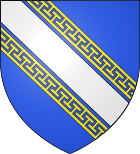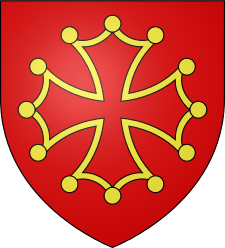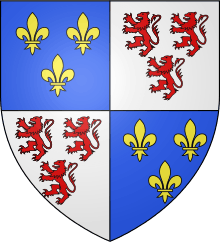French heraldry
.svg.png)
French heraldry is the use of heraldic symbols in France. Although it had a considerable history, existing from the 11th century, such formality has largely died out in France, as far as regulated personal heraldry is concerned. Civic heraldry on the other hand remains a visible part of daily life.
The role of the herald (héraut) in France declined in the 17th century. Today the law recognises both assumed and inherited arms, considering them under law to be equivalent to a visual representation of a name, and given the same protections. However, there is no central registry of arms; in case of dispute, the individual who can prove the longest right to the blazon must be decided in court.
Many of the terms in international heraldry come from French.
Characteristics
Like the British system of heraldry, the French follow the Rule of Tinctures. This states that there are two types of Tinctures (heraldic colors): the colors Sable (black), Gules (red), Vert (green) and Azure (blue) and metals Or (gold or yellow) and Argent (silver or white). For sake of visibility (the whole point of the system), no Charges of a color can be used on a field of a color and no Charges of a metal can be used on a field of a metal, nor can the divisions of the field be color-on-color or metal-on-metal. Arms that do not follow the Rule of Tinctures are referred to as Armes pour enquérir (a "Coat of Arms to be investigated").
French heraldry has a set system of crown and coronets.[1] Supporters are not linked with any rank or title, unlike the coronets, and are far less common than in other forms of European heraldry, such as English heraldry.[1] Even the Royal Arms' angelic supporters are not shown in most depictions. Crests are rare in modern depictions, again in contrast to England.[1]
French crowns and coronets
| Commune | Department Capital | Capital |
Ancient Regime
| Baron | Vidame | Vicomte (Viscount) | Comte (Count) | Comte et Pair de France (Count and Peer of France) | Marquis | Marquis et Pair de France (Marquis and Peer of France) |
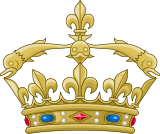 |
 | |||||
| Duc (Duke) | Duc et Pair de France (Dukes and Peer of France) | Prince du Sang or Fils de France (Son of France, nobles in the descendance of Saint Louis) | Prince de Sang Royal (Royal Prince, children of the King) | Dauphin (heir apparent), (Dauphin de Viennois) | Roi (King) |
National Emblem of France
| National Emblem of France | |
|---|---|
 | |
| Details | |
| Armiger | The French Republic |
| Escutcheon | RF, standing for République française |
| Other elements | Fasces, laurel branch, oak branch |
The current emblem of France has been a symbol of France since 1953, although it does not have any legal status as an official coat of arms. It appears on the cover of French passports and was originally adopted by the French Foreign Ministry as a symbol for use by diplomatic and consular missions in 1912 using a design drawn up by the sculptor Jules-Clément Chaplain.
In 1953, France received a request from the United Nations for a copy of the national coat of arms to be displayed alongside the coats of arms of other member states in its assembly chamber. An interministerial commission requested Robert Louis (1902–1965), heraldic artist, to produce a version of the Chaplain design. This did not, however, constitute an adoption of an official coat of arms by the Republic.
Technically speaking, it is an emblem rather than a coat of arms, since it does not respect heraldic rules—heraldry being seen as an aristocratic art, and therefore associated with the Ancien Régime. The emblem consists of:
- A wide shield with lion-head terminal bears a monogram "RF" standing for République Française (French Republic).
- A laurel branch symbolises victory of the Republic.
- An oak branch symbolises perennity or wisdom.
- The fasces is a symbol associated with justice (from Roman lictor's axes, in this case not fascism).
Fleur-de-lys

The fleur-de-lys (or fleur-de-lis, plural: fleurs-de-lis; /ˌflɜːrdəˈliː/, [ˌflœː(ʀ)dəˈlɪs] in Quebec French), translated from French as "lily flower") is a stylized design of either an iris or a lily that is now used purely decoratively as well as symbolically, or it may be "at one and the same time political, dynastic, artistic, emblematic and symbolic",[2] especially in heraldry.
While the fleur-de-lis has appeared on countless European coats of arms and flags over the centuries, it is particularly associated with the French monarchy on a historical context, and nowadays with the Spanish monarchy and the Grand Duchy of Luxembourg as the only remaining monarchs of the House of Bourbon.
It is an enduring symbol of France that appears on French postage stamps but has not been adopted officially by any of the French republics.
Arms of major cities
All cities within France have coats of arms; these are often intertwined with local traditions over history.
ParisMain article: Coat of arms of Paris
 The coat of arms of the city of Paris, in its current form, dates back to 1358, when King Charles V officially installed it.[3] On the coat of arms, the represented vessel is the symbol of the powerful corporate body of the Marchands de l'eau, dating back to the Middle Ages. The city motto, "Fluctuat nec mergitur" ("It is beaten by the waves without being submerged") is equally a reference to this boat. Marseille The arms of Marseilles, passed in 1930, may be emblazoned as: Argent a cross azur. The motto of Marseille is: De grands fachs resplend la cioutat de Marseilles (Occitan), appears for the first time in 1257; La Ville de Marseille resplendit par ses hauts faits (French); Actibus immensis urbs fulget Massiliensis (Latin, used since 1691) or 'The City of Marseille shines by its deeds'. See also: Marseille's heraldry on fr.wikipedia
Lyon.svg.png) The arms of Lyon date back to the Middle Ages, when they were those of the Counts of Lyon. They constituted of a rampant (ready to pounce) argent (silver) lion on a red field, with a clearly identifiable tongue. It is around 1320 that the chief azure three fleurs de lys d'or, the upper band still present on the arms, was added to the lion symbolizing royal protection. n 1819, a sword was granted by the king in recognition of services to the king during the events of 1793. The July Monarchy of 1830 rejected the fleurs de lys and replaced them with stars that were intended to be neutral. In the early 20th century, the municipality decided to take the lion coat of arms without sword, with three fleurs de lys, the emblem of the city for six centuries. The shield reads not as a symbol, but as a riddle: the argent lion is canted: it is a pun on the city's name, "Lyon". See also: Lyon's heraldry on fr.wikipedia
|
Strasbourg Strasbourg's arms are the colours of the shield of the Bishop of Strasbourg (a band of red on a white field, also considered an inversion of the arms of the diocese) at the end of a revolt of the burghers during the Middle Ages who took their independence from the teachings of the Bishop. It retains its power over the surrounding area. See also: Strasbourg's heraldry on fr.wikipedia
Nice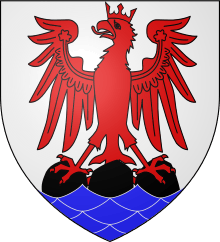 The arms of Nice first appear in 1430.[4] The Nice is symbolized by a red eagle on white background, on top of three mountains. The arms has undergone only minor changes: the eagle become more and more stylized, a crown of a count has been added, which symbolizes his dominion over the County of Nice, and the three mountains on which is based is now surrounded by a stylised sea.[4] The presence of the eagle, imperial emblem, shows that these arms are linked to savoyard power.Throughout their symbolic structure, the arms of Nice are a sign of allegiance and fidelity to the House of Savoy.[4] The combination of white and red (argent and gules) is a resumption of the Cross of Savoy.[4] The three mountains symbolize a territorial honor, without concern for geographic realism.[4] See also: Nice's heraldry on fr.wikipedia
Grenoble.svg.png) The coat of arms of the city of Grenoble dates back to the 14th century.[5] The three roses are symbolic representation of the three authorities who governed the city in the Middle Ages. Grenoble was placed under the authority of two rival powers, that of the bishop and of the Dauphin. In the 14th century appears a third authority, consuls, elected by the people and defenders of freedoms and exemptions granted by the two co-lords. See also: Grenoble's heraldry on fr.wikipedia
|
Regions of France
Each region of France has its own coat of arms, although usage varies:
Départments
Few départments have official arms. There may be substantial disagreements with this table.
|
|
|
|
See also
References
- 1 2 3 François Velde (2003-02-06). "French Heraldry: National Characteristics". Heraldica. Retrieved 2009-02-22.
- ↑ Michel Pastoureau, Heraldry: its origins and meaning translated by Francisca Garvie (Thames and Hudson 1997), ISBN 0-500-30074-7, p.98
- ↑ Faure, Juliet (2002). L'arsenal de Paris: histoire et chroniques (in French). L'Harmattan. p. 35.
- 1 2 3 4 5 Ralph Schor, Histoire du Comté de Nice en 100 dates, Alandis Editions, 2007, p. 22-23 (in French)
- ↑ Histoire du blason de Grenoble (in French)






